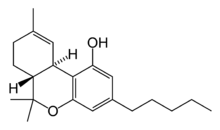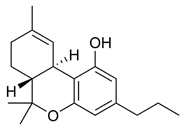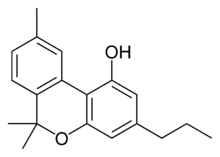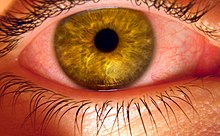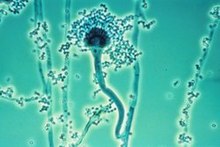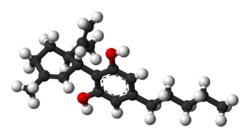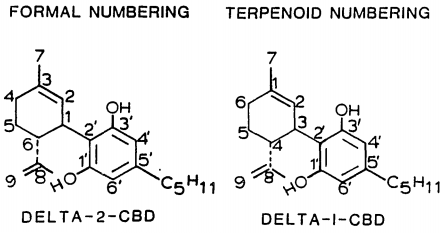From Wikipedia, the free encyclopedia
Acute effects while under the influence can include
euphoria and
anxiety.
Cannabidiol
(CBD), another cannabinoid found in cannabis in varying amounts, has
been shown to alleviate the adverse effects of THC that some consumers
experience.
When ingested orally, THC can produce stronger psychotropic effects
than when inhaled. At doses exceeding the psychotropic threshold, users
may experience adverse side effects such as anxiety and panic attacks
that can result in increased heart rate and changes in blood pressure.
In the
United States research about
medical cannabis has been hindered by federal law. Smoking any substance could possibly carry similar risks as smoking tobacco due to carcinogens in all smoke, and the ultimate conclusions on these factors are disputed.
Effects
Cannabinoids and cannabinoid receptors
The most prevalent
psychoactive substances in
cannabis are
cannabinoids, particularly
THC. Some varieties, having undergone careful selection and growing techniques, can yield as much as 34% THC. Another psychoactive cannabinoid present in
Cannabis sativa is
tetrahydrocannabivarin (THCV), but it is only found in small amounts and is a cannabinoid antagonist.
There are similar compounds in cannabis that do not exhibit psychoactive response but are obligatory for functionality:
cannabidiol (CBD), an
isomer of THC;
cannabivarin (CBV), an
analog of
cannabinol (CBN) with a different
side chain,
cannabidivarin (CBDV), an analog of CBD with a different side chain, and
cannabinolic acid.
How these other compounds interact with THC is not fully understood.
Some clinical studies have proposed that CBD acts as a balancing agent
to regulate the strength of the psychoactive agent THC. CBD is believed
to regulate the metabolism of THC by inactivating
cytochrome P450,
an important class of enzymes that metabolize drugs. Experiments in
which babies were treated with CBD followed by THC showed that CBD was
associated with a substantial increase in brain concentrations of THC
and its major metabolites, most likely because it decreased the rate of
clearance of THC from the body. Cannabis
cofactors have also been linked to lowering
body temperature, modulating immune function, and cell protection. The
essential oil of cannabis contains many fragrant
terpenoids which may synergize with the cannabinoids to produce their unique effects. THC is converted rapidly to
11-hydroxy-THC, which is also pharmacologically active, so the euphoria outlasts measurable THC levels in blood.
The cannabinoid receptor is a typical
G protein-coupled receptor. A characteristic of this type of receptor is the distinct pattern of how the molecule spans the
cell membrane seven times. Cannabinoid receptors are located on the cell membrane, and both outside (
extracellularly) and inside (
intracellularly)
the cell membrane. CB1 receptors, the bigger of the two, are
extraordinarily abundant in the brain: 10 times more plentiful than the
μ-
opioid receptors responsible for the effects of
morphine.
CB2 receptors are structurally different (the sequence similarity
between the two subtypes of receptors is 44%), found only on cells of
the immune system, and seems to function similarly to its CB1
counterpart. CB2 receptors are most prevalent on
B-cells,
natural killer cells, and
monocytes, but can also be found on
polymorphonuclear neutrophil cells,
T8 cells, and
T4 cells. In the
tonsils the CB2 receptors appear to be restricted to
B-lymphocyte-enriched areas.
Biochemical mechanisms in the brain
Cannabinoids usually contain a 1,1'-di-methyl-pyran ring, a variedly derivatized
aromatic ring and a variedly
unsaturated cyclohexyl
ring and their immediate chemical precursors, constituting a family of
about 60 bi-cyclic and tri-cyclic compounds. Like most other
neurological processes, the effects of cannabis on the brain follow the
standard protocol of
signal transduction, the
electrochemical system of sending signals through
neurons for a biological response. It is now understood that cannabinoid receptors appear in similar forms in most
vertebrates and
invertebrates and have a long
evolutionary history of 500 million years. The binding of cannabinoids to cannabinoid receptors decrease
adenylyl cyclase activity, inhibit
calcium N channels, and disinhibit
K+A channels. There are at least two types of cannabinoid receptors (CB1 and CB2).
The
CB1 receptor is found primarily in the brain and mediates the
psychological effects of THC. The
CB2 receptor is most abundantly found on cells of the
immune system. Cannabinoids act as
immunomodulators
at CB2 receptors, meaning they increase some immune responses and
decrease others. For example, nonpsychotropic cannabinoids can be used
as a very effective
anti-inflammatory.
The affinity of cannabinoids to bind to either receptor is about the
same, with only a slight increase observed with the plant-derived
compound CBD binding to CB2 receptors more frequently. Cannabinoids
likely have a role in the brain’s control of
movement and
memory,
as well as natural pain modulation. It is clear that cannabinoids can
affect pain transmission and, specifically, that cannabinoids interact
with the brain's endogenous
opioid system and may affect dopamine transmission.
Sustainability in the body
Most
cannabinoids are
lipophilic (fat soluble) compounds that are easily stored in fat, thus yielding a long
elimination half-life relative to other
recreational drugs.
The THC molecule, and related compounds, are usually detectable in drug
tests from 3 days up to 10 days according to Redwood Laboratories;
long-term users can produce positive tests for two to three months after
ceasing cannabis use.
Toxicities
Related to cannabinoids
No fatal overdoses with cannabis use have been reported. A review published in the British Journal of Psychiatry in February 2008 said that "no deaths directly due to acute cannabis use have ever been reported".
THC, the principal
psychoactive constituent of the cannabis plant, has an extremely low
toxicity
and the amount that can enter the body through the consumption of
cannabis plants poses no threat of death. In dogs, the minimum lethal
dose of THC is over 3 g/kg.
According to the
Merck Index, the
LD50
of THC (the dose which causes the death of 50% of individuals) is
1270 mg/kg for male rats and 730 mg/kg for female rats from oral
consumption in sesame oil, and 42 mg/kg for rats from inhalation.
It is important though to note that cannabinoids and other
molecules present in cannabis can alter the metabolism of other drugs,
especially due to competition for clearing metabolic pathways such as
cytochromes CYP450, thus leading to drug toxicities by medications that the person consuming cannabis may be taking.
Related to smoking
A 2007 study found that while tobacco and cannabis smoke are quite similar, cannabis smoke contained higher amounts of
ammonia,
hydrogen cyanide, and
nitrogen oxides, but lower levels of carcinogenic
polycyclic aromatic hydrocarbons (PAHs).
This study found that directly inhaled cannabis smoke contained as much
as 20 times as much ammonia and 5 times as much hydrogen cyanide as
tobacco smoke and compared the properties of both mainstream and
sidestream (smoke emitted from a smouldering 'joint' or 'cone') smoke.
Mainstream cannabis smoke was found to contain higher concentrations of
selected polycyclic aromatic hydrocarbons (PAHs) than sidestream
tobacco smoke.
However, other studies have found much lower disparities in ammonia and
hydrogen cyanide between cannabis and tobacco, and that some other
constituents (such as polonium-210, lead, arsenic, nicotine, and
tobacco-specific nitrosamines) are either lower or non-existent in
cannabis smoke.
Cannabis smoke contains thousands of organic and inorganic chemical compounds. This
tar is chemically similar to that found in tobacco smoke or cigars. Over fifty known
carcinogens have been identified in cannabis smoke. These include nitrosamines, reactive aldehydes, and polycylic hydrocarbons, including benz[a]pyrene. Marijuana smoke was listed as a cancer agent in California in 2009. A study by the
British Lung Foundation
published in 2012 identifies cannabis smoke as a carcinogen and also
finds awareness of the danger is low compared with the high awareness of
the dangers of smoking tobacco particularly among younger users. Other
observations include possible increased risk from each cigarette; lack
of research on the effect of cannabis smoke alone; low rate of addiction
compared to tobacco; and episodic nature of cannabis use compared to
steady frequent smoking of tobacco. Professor
David Nutt,
a UK drug expert, points out that the study cited by the British Lung
Foundation has been accused of both "false reasoning" and "incorrect
methodology". Further, he notes that other studies have failed to
connect cannabis with lung cancer, and accuses the BLF of
"scaremongering over cannabis".
Short-term effects
When smoked, the short-term effects of cannabis manifest within seconds and are fully apparent within a few minutes, typically lasting for 1–3 hours, varying by the person and the strain of cannabis.
After oral ingestion of cannabis, the onset of effect is delayed
relative to smoking, taking 30 minutes to 2 hours, but the duration is
prolonged due to continued slow absorption.
The duration of noticeable effects has been observed to diminish after
prolonged, repeated use and the development of increased tolerance to
cannabinoids.
Psychological effects
The psychoactive effects of cannabis, known as a "
high", are subjective and vary among persons and the method of use.
When
THC enters the blood stream and reaches the brain, it binds to
cannabinoid receptors. The
endogenous ligand of these receptors is
anandamide, the effects of which THC emulates. This
agonism of the cannabinoid receptors results in changes in the levels of various neurotransmitters, especially
dopamine and
norepinephrine; neurotransmitters which are closely associated with the acute effects of cannabis ingestion, such as
euphoria and
anxiety.
Some effects may include a general
alteration of conscious perception,
euphoria,
feelings of well-being, relaxation or stress reduction, increased
appreciation of the arts, including humor and music (especially
discerning its various components/instruments), joviality,
metacognition and
introspection, enhanced recollection (
episodic memory), increased sensuality, increased awareness of sensation, increased
libido, and creativity. Abstract or philosophical thinking, disruption of linear memory and
paranoia or
anxiety are also typical.
Anxiety
is the most commonly reported side effect of smoking marijuana. Between
20 and 30 percent of recreational users experience intense anxiety
and/or
panic attacks after smoking cannabis, however, some report anxiety only after not smoking cannabis for a prolonged period of time. Inexperience and use in an unfamiliar environment are major contributing factors to this anxiety.
Cannabidiol
(CBD), another cannabinoid found in cannabis in varying amounts, has
been shown to ameliorate the adverse effects of THC, including anxiety,
that some consumers experience.
Any episode of acute psychosis that accompanies cannabis use
usually abates after 6 hours, but in rare instances, heavy users may
find the symptoms continuing for many days. If the episode is accompanied by aggression or sedation, physical restraint may be necessary.
While psychoactive drugs are typically categorized as
stimulant,
depressant, or
hallucinogen, cannabis exhibits a mix of all of them, perhaps leaning more towards hallucinogenic or
psychedelic properties, though with other effects quite pronounced. THC is considered the primary active component of the cannabis plant.
Scientific studies have suggested that other cannabinoids like CBD may also play a significant role in its psychoactive effects.
Somatic effects
Duration
Peak levels of cannabis-associated intoxication occur approximately 30 minutes after smoking it and last for several hours.
Smoked
The total
short-term duration of cannabis use when smoked depends on the potency,
method of smoking – e.g. whether pure or in conjunction with tobacco –
and how much is smoked. Peak levels of intoxication typically last an
average of three to four hours.
Oral
When taken
orally (in the form of capsules, food or drink), the psychoactive
effects take longer to manifest and generally last longer, typically
lasting for an average of four to ten hours after consumption.
Very high doses may last even longer. Also, oral ingestion use
eliminates the need to inhale toxic combustion products created by
smoking and therefore negates the risk of respiratory harm associated
with cannabis smoking.
Neurological effects
The areas of the brain where cannabinoid receptors are most prevalent are consistent with the
behavioral effects produced by cannabinoids. Brain regions in which cannabinoid receptors are very abundant are the
basal ganglia, associated with movement control; the
cerebellum, associated with body movement coordination; the
hippocampus, associated with
learning, memory, and
stress control; the
cerebral cortex, associated with higher cognitive functions; and the
nucleus accumbens, regarded as the reward center of the brain. Other regions where cannabinoid receptors are moderately concentrated are the
hypothalamus, which regulates homeostatic functions; the
amygdala, associated with emotional responses and
fears; the
spinal cord, associated with peripheral sensations like pain; the
brain stem, associated with
sleep,
arousal, and motor control; and the
nucleus of the solitary tract, associated with visceral sensations like
nausea and
vomiting.
Experiments on animal and human tissue have demonstrated a disruption of
short-term memory formation,
which is consistent with the abundance of C receptors on the
hippocampus, the region of the brain most closely associated with
memory. Cannabinoids inhibit the release of several neurotransmitters in
the hippocampus such as
acetylcholine,
norepinephrine, and
glutamate, resulting in a decrease in neuronal activity in that area.
In
in-vitro experiments THC at extremely high concentrations, which could not be reached with commonly consumed doses, caused
competitive inhibition of the
AChE enzyme and inhibition of
β-amyloid peptide aggregation, implicated in the development of
Alzheimer's disease.
Compared to currently approved drugs prescribed for the treatment of
Alzheimer's disease, THC is a considerably superior inhibitor of A
aggregation, and this study provides a previously unrecognized molecular
mechanism through which cannabinoid molecules may impact the
progression of this debilitating disease.
Effects on driving
While several studies have shown increased risk associated with
cannabis use by drivers, other studies have not found increased risk. Cannabis usage has been shown in some studies to have a negative effect on driving ability.
The British Medical Journal indicated that "drivers who consume cannabis
within three hours of driving are nearly twice as likely to cause a
vehicle collision as those who are not under the influence of drugs or
alcohol".
In
Cannabis and driving: a review of the literature and commentary, the United Kingdom's
Department for Transport
reviewed data on cannabis and driving, finding although impaired,
"subjects under cannabis treatment appear to perceive that they are
indeed impaired. Where they can compensate, they do...".
In a review of driving simulator studies, researchers note that "even
in those who learn to compensate for a drug's impairing effects,
substantial impairment in performance can still be observed under
conditions of general task performance (i.e. when no contingencies are
present to maintain compensated performance)."
A 2012 meta-analysis found that acute cannabis use increased the risk of an automobile crash.
An extensive 2013 review of 66 studies regarding crash risk and drug
use found that cannabis was associated with minor, but not statistically
significant increased odds of injury or fatal accident.
In the largest and most precisely controlled study of its kind carried out by the U.S. Department of Transportation’s
National Highway Traffic Safety Administration,
it was found that other "studies that measure the presence of THC in
the drivers' blood or oral fluid, rather than relying on self-report
tend to have much lower (or no) elevated crash risk estimates. Likewise
better controlled studies have found lower (or no) elevated crash risk
estimates".
The study found that "after adjusting for age, gender, race and alcohol
use, drivers who tested positive for marijuana were no more likely to
crash than those who had not used any drugs or alcohol prior to
driving".
On the other hand, a recent study of
Journal of Transport & Health
indicated that the numbers of fatal crashes involving marijuana after
the recreational marijuana legalization or decriminalization have
significantly increased in Colorado, Washington, and Massachusetts.
Cardiovascular effects
Short-term
(one to two hours) effects on the cardiovascular system can include
increased heart rate, dilation of blood vessels, and fluctuations in
blood pressure. There are medical reports of occasional heart attacks or
myocardial infarction,
stroke and other cardiovascular side effects. Marijuana's cardiovascular effects are not associated with serious health problems for most young, healthy users. Researchers reported in the
International Journal of Cardiology, "Marijuana use by older people, particularly those with some degree of
coronary artery or
cerebrovascular disease, poses greater risks due to the resulting increase in
catecholamines,
cardiac workload, and
carboxyhemoglobin levels, and concurrent episodes of profound postural
hypotension. Indeed, marijuana may be a much more common cause of
myocardial infarction
than is generally recognized. In day-to-day practice, a history of
marijuana use is often not sought by many practitioners, and even when
sought, the patient's response is not always truthful".
A 2013 analysis of 3,886 myocardial infarction survivors over an
18-year period showed "no statistically significant association between
marijuana use and mortality".
Cannabis arteritis is a very rare peripheral vascular disease similar to
Buerger's disease. There were about 50 confirmed cases from 1960 to 2008, all of which occurred in Europe.
Combination with other drugs
A confounding factor in cannabis research is the prevalent usage of other recreational drugs, especially
alcohol and nicotine.
Such complications demonstrate the need for studies on cannabis that
have stronger controls, and investigations into alleged symptoms of
cannabis use that may also be caused by tobacco. Some critics question
whether agencies doing the research make an honest effort to present an
accurate, unbiased summary of the evidence, or whether they
"cherry-pick" their data to please funding sources which may include the
tobacco industry or governments dependent on cigarette tax revenue;
others caution that the raw data, and not the final conclusions, are
what should be examined.
The Australian National Household Survey of 2001
showed that cannabis in Australia is rarely used without other drugs.
95% of cannabis users also drank alcohol; 26% took amphetamines; 19%
took ecstasy and only 2.7% reported not having used any other drug with
cannabis.
While research has been undertaken on the combined effects of alcohol
and cannabis on performing certain tasks, little research has been
conducted on the reasons why this combination is so popular. Evidence
from a controlled experimental study undertaken by Lukas and Orozco
suggests that alcohol causes THC to be absorbed more rapidly into the
blood plasma of the user. Data from the Australian National Survey of
Mental Health and Wellbeing
found that three-quarters of recent cannabis users reported using
alcohol when cannabis was not available, this suggests that the two are
substitutes.
Memory and learning
Studies on cannabis and memory are hindered by small sample sizes, confounding drug use, and other factors.
The strongest evidence regarding cannabis and memory focuses on its
temporary negative effects on short-term and working memory.
In a 2001 study looking at neuropsychological performance in
long-term cannabis users, researchers found "some cognitive deficits
appear detectable at least 7 days after heavy cannabis use but appear
reversible and related to recent cannabis exposure rather than
irreversible and related to cumulative lifetime use". On his studies regarding cannabis use, lead researcher and Harvard professor
Harrison Pope
said he found marijuana is not dangerous over the long term, but there
are short-term effects. From neuropsychological tests, Pope found that
chronic cannabis users showed difficulties, with verbal memory in
particular, for "at least a week or two" after they stopped smoking.
Within 28 days, memory problems vanished and the subjects "were no
longer distinguishable from the comparison group".
Researchers from the
University of California, San Diego School of Medicine
failed to show substantial, systemic neurological effects from
long-term recreational use of cannabis. Their findings were published in
the July 2003 issue of the
Journal of the International Neuropsychological Society. The research team, headed by Dr Igor Grant, found that cannabis use did affect perception, but did not cause permanent
brain damage.
Researchers looked at data from 15 previously published controlled
studies involving 704 long-term cannabis users and 484 nonusers. The
results showed long-term cannabis use was only marginally harmful on the
memory and learning. Other functions such as reaction time, attention,
language, reasoning ability, perceptual and motor skills were
unaffected. The observed effects on memory and learning, they said,
showed long-term cannabis use caused "selective memory defects", but
that the impact was "of a very small magnitude". A study at
Johns Hopkins University School of Medicine
showed that very heavy use of marijuana is associated with decrements
in neurocognitive performance even after 28 days of abstinence.
Appetite
The feeling of increased appetite following the use of
cannabis has been documented for hundreds of years,
and is known colloquially as "the munchies" in the English-speaking
world. Clinical studies and survey data have found that cannabis
increases food enjoyment and interest in food. A 2015 study suggests that cannabis triggers uncharacteristic behaviour in
POMC neurons, which are usually associated with decreasing hunger. Rarely, chronic users experience a severe vomiting disorder,
cannabinoid hyperemesis syndrome, after smoking and find relief by taking hot baths.
Endogenous cannabinoids ("endocannabinoids") were discovered in cow's milk and soft cheeses.
Endocannabinoids are also found in human breast milk.
It is widely accepted that the neonatal survival of many species "is
largely dependent upon their suckling behavior, or appetite for breast
milk"
and recent research has identified the endogenous cannabinoid system to
be the first neural system to display complete control over milk
ingestion and neonatal survival.
It is possible that "cannabinoid receptors in our body interact with
the cannabinoids in milk to stimulate a suckling response in newborns so
as to prevent growth failure".
Pathogens and microtoxins
Most
microorganisms
found in cannabis only affect plants and not humans, but some
microorganisms, especially those that proliferate when the herb is not
correctly dried and stored, can be harmful to humans. Some users may
store marijuana in an airtight bag or jar in a
refrigerator to prevent fungal and bacterial growth.
Fungi
The fungi
Aspergillus flavus,
Aspergillus fumigatus,
Aspergillus niger,
Aspergillus parasiticus,
Aspergillus tamarii,
Aspergillus sulphureus,
Aspergillus repens,
Mucor hiemalis (not a human pathogen),
Penicillium chrysogenum,
Penicillium italicum and
Rhizopus nigrans have been found in moldy cannabis.
Aspergillus mold species can infect the lungs via smoking or handling of infected cannabis and cause opportunistic and sometimes deadly
aspergillosis. Some of the microorganisms found create
aflatoxins, which are
toxic and
carcinogenic. Researchers suggest that moldy cannabis should thus be discarded to avoid these serious risks.
Mold is also found in smoke from mold-infected cannabis,
and the lungs and nasal passages are a major means of contracting
fungal infections. Levitz and Diamond (1991) suggested baking marijuana
in home ovens at 150 °C [302 °F], for five minutes before smoking. Oven
treatment killed
conidia of
A. fumigatus,
A. flavus and
A. niger, and did not degrade the active component of marijuana, tetrahydrocannabinol (THC)."
Bacteria
Long-term effects
Exposure to marijuana may have biologically-based physical, mental,
behavioral and social health consequences and is "associated with
diseases of the liver (particularly with co-existing hepatitis C),
lungs, heart, eyesight and vasculature" according to a 2013 literature
review by Gordon and colleagues. The association with these diseases has
only been reported in cases where people have smoked cannabis. The
authors cautioned that "evidence is needed, and further research should
be considered, to prove causal associations of marijuana with many
physical health conditions".
Effects in pregnancy
Cannabis consumption in pregnancy might be associated with
restrictions in growth of the fetus, miscarriage, and cognitive deficits
in offspring based on animal studies, although there is limited
evidence for this in humans at this time. A 2012
systematic review
found although it was difficult to draw firm conclusions, there was
some evidence that prenatal exposure to cannabis was associated with
"deficits in language, attention, areas of cognitive performance, and
delinquent behavior in adolescence". A report prepared for the
Australian National Council on Drugs concluded cannabis and other
cannabinoids are contraindicated in pregnancy as it may interact with the
endocannabinoid system.

